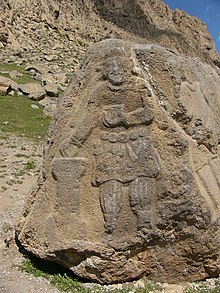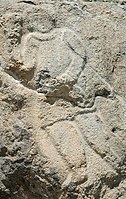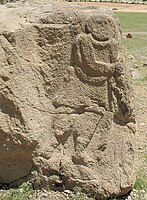17:
120:
108:
96:
302:
59:
king with a bowl in his left hand. It also has an inscription, which identities the king as
Vologases. Six kings named Vologases are known to have ruled the Parthian Empire, from 51 to the 220s CE. The inscription may refer to
119:
107:
363:
16:
373:
339:
180:
218:
89:
Vologases is seen frontally, holding a bowl and sacrificing at an altar, and is flanked by two attendants carved on the sides of the rock.
52:
95:
249:
358:
368:
332:
241:
The
Iranian Expanse: Transforming Royal Identity through Architecture, Landscape, and the Built Environment, 550 BCE–642 CE
301:
325:
188:
270:
44:
245:
214:
208:
309:
238:
Canepa, Matthew P. (2018). "The Rise of the
Arsacids and a New Iranian Topography of Power".
72:
283:
56:
68:. This historical heritage was listed in Iranian national heritages on 10 March 2002.
352:
65:
79:
Vologases, King of Kings, son of (Vo)l(ogases), K(ing of Kings), grandson of P(...)
61:
71:
The inscription, written in nine lines on the surface of the altar, uses the
262:"The Sacral Kingship of the early Arsacids. I. Fire Cult and Kingly Glory"
185:
Archive of
Cultural Heritage, Handicrafts and Tourism Organization of Iran
308:
This article about an
Iranian building or structure related topic is a
210:
Imaginary Kings: Royal Images in the
Ancient Near East, Greece and Rome
75:
script to transcribe the
Parthian language logographically, and reads:
40:
21:
36:
261:
239:
48:
25:
313:
181:"Files of registration of Iranian national heritages"
260:
244:. University of California Press. pp. 1–512.
77:
333:
8:
364:Tourist attractions in Kermanshah province
340:
326:
213:. Franz Steiner Verlag. pp. 140–142.
207:Hekster, Olivier; Fowler, Richard (2005).
125:Attendant at the proper right of the King
167:
113:Attendant at the proper left of the King
15:
136:
91:
279:
268:
155:
143:
7:
374:Iranian building and structure stubs
298:
296:
202:
200:
198:
312:. You can help Knowledge (XXG) by
14:
300:
118:
106:
94:
39:located in the ancient site of
1:
259:Olbrycht, Marek Jan (2016).
390:
295:
53:UNESCO world heritage site
359:National works of Iran
278:Cite journal requires
87:
84:Vologases inscription.
28:
20:The Parthian Stone in
369:Parthian rock reliefs
19:
45:Kermanshah Province
29:
321:
320:
220:978-3-515-08765-0
146:, pp. 81–81.
381:
342:
335:
328:
304:
297:
287:
281:
276:
274:
266:
264:
255:
225:
224:
204:
193:
192:
187:. Archived from
177:
171:
165:
159:
153:
147:
141:
122:
110:
98:
85:
389:
388:
384:
383:
382:
380:
379:
378:
349:
348:
347:
346:
293:
277:
267:
258:
252:
237:
234:
229:
228:
221:
206:
205:
196:
179:
178:
174:
166:
162:
154:
150:
142:
138:
133:
126:
123:
114:
111:
102:
99:
86:
83:
12:
11:
5:
387:
385:
377:
376:
371:
366:
361:
351:
350:
345:
344:
337:
330:
322:
319:
318:
305:
289:
288:
280:|journal=
256:
250:
233:
230:
227:
226:
219:
194:
191:on 2015-10-23.
172:
160:
148:
135:
134:
132:
129:
128:
127:
124:
117:
115:
112:
105:
103:
100:
93:
81:
33:Parthian Stone
13:
10:
9:
6:
4:
3:
2:
386:
375:
372:
370:
367:
365:
362:
360:
357:
356:
354:
343:
338:
336:
331:
329:
324:
323:
317:
315:
311:
306:
303:
299:
294:
291:
285:
272:
263:
257:
253:
251:9780520964365
247:
243:
242:
236:
235:
231:
222:
216:
212:
211:
203:
201:
199:
195:
190:
186:
182:
176:
173:
170:, p. 96.
169:
168:Olbrycht 2016
164:
161:
158:, p. 81.
157:
152:
149:
145:
140:
137:
130:
121:
116:
109:
104:
97:
92:
90:
80:
76:
74:
69:
67:
66:Vologases III
63:
58:
55:. It shows a
54:
50:
46:
42:
38:
34:
27:
23:
18:
314:expanding it
307:
292:
290:
271:cite journal
240:
209:
189:the original
184:
175:
163:
151:
139:
88:
78:
70:
32:
30:
156:Canepa 2018
144:Canepa 2018
62:Vologases I
353:Categories
131:References
265:: 91–106.
101:Vologases
82:—
57:Parthian
232:Sources
73:Aramaic
41:Bisotun
22:Bisotun
248:
217:
37:relief
35:is a
310:stub
284:help
246:ISBN
215:ISBN
51:, a
49:Iran
31:The
26:Iran
64:or
43:in
355::
275::
273:}}
269:{{
197:^
183:.
47:,
24:,
341:e
334:t
327:v
316:.
286:)
282:(
254:.
223:.
Text is available under the Creative Commons Attribution-ShareAlike License. Additional terms may apply.



